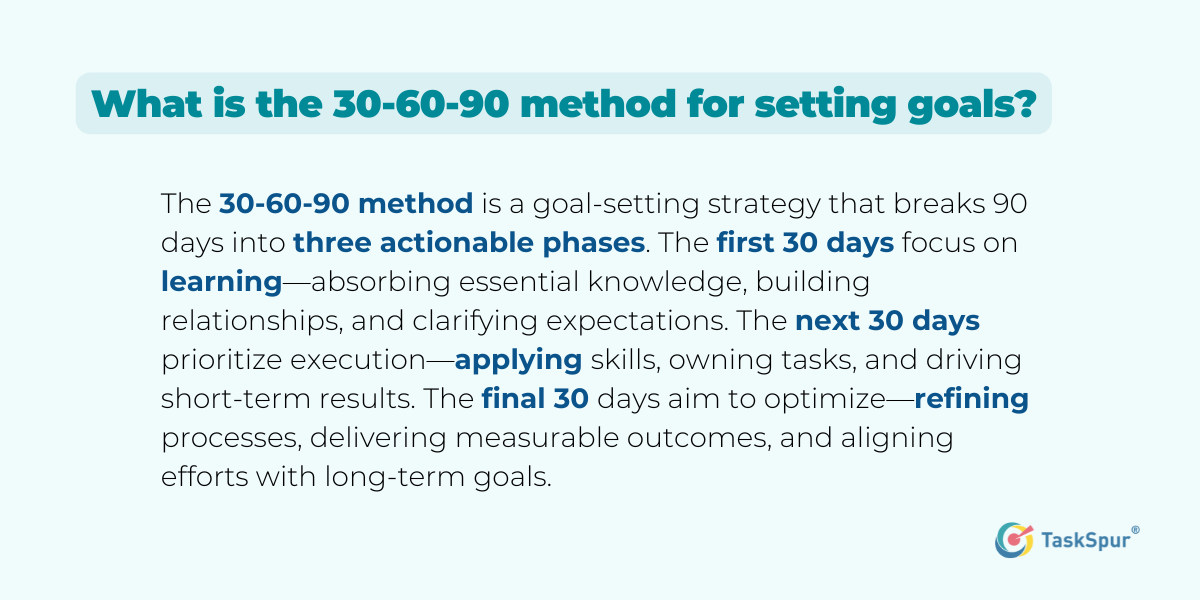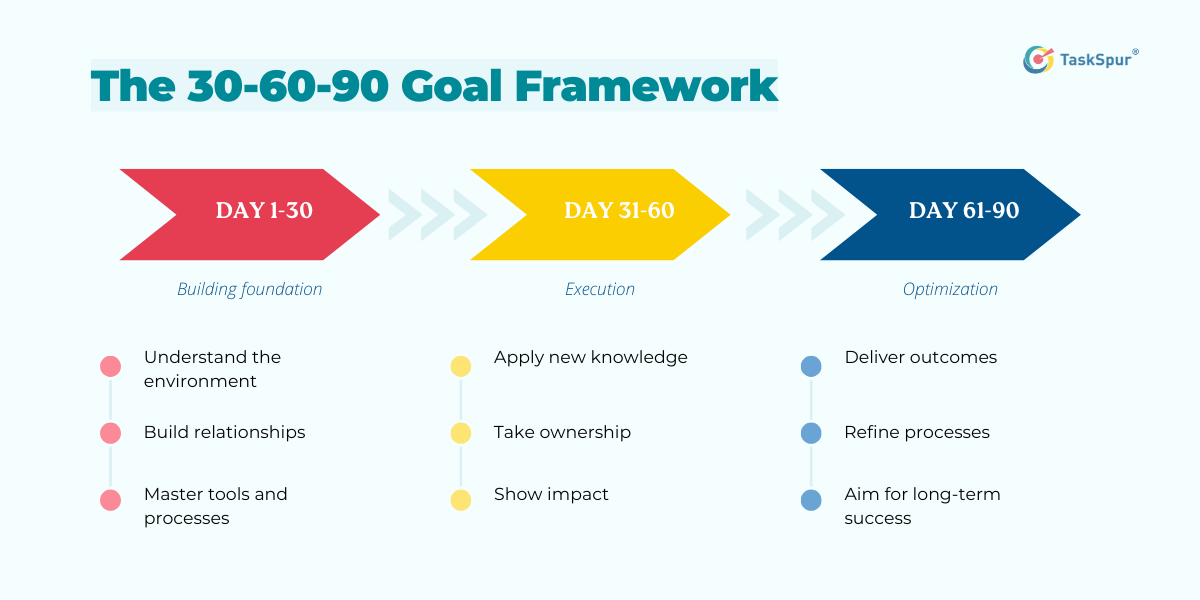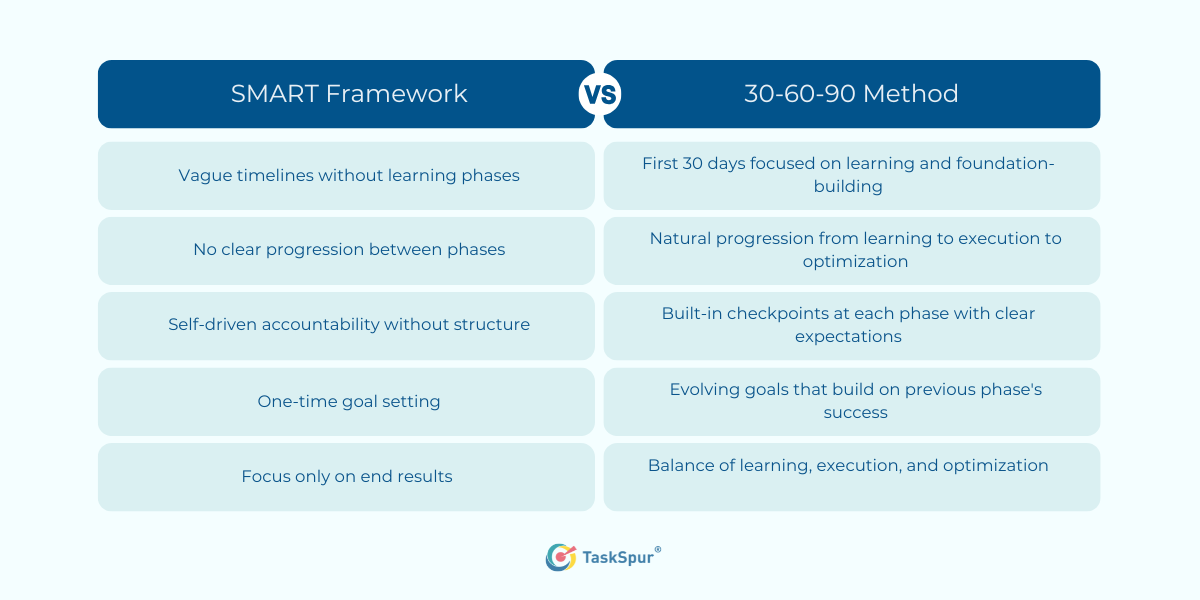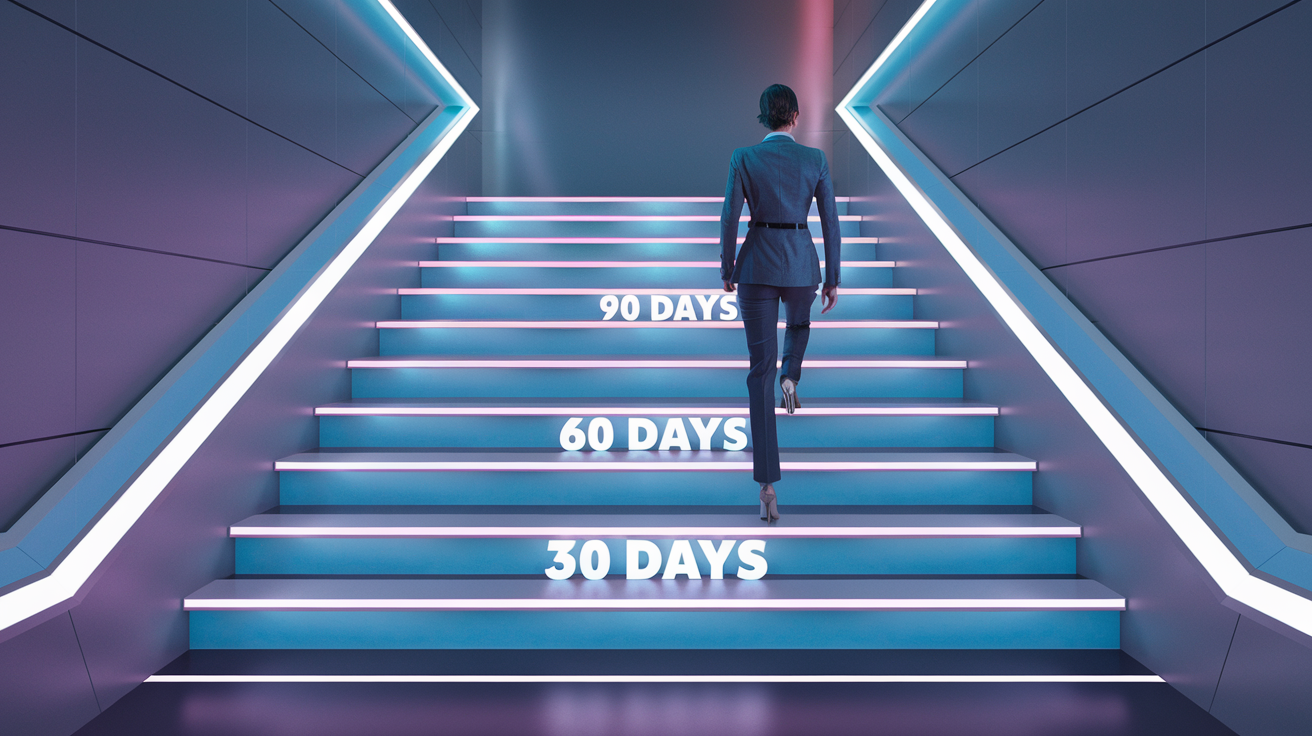How to Implement the 30-60-90 Method for Achieving Goals
Most people fail to achieve their goals not because they lack motivation, but because they lack a system.
The numbers tell a clear story. By the end of January, 88% of New Year's resolutions have already failed. By March, that number climbs to 90%. Traditional goal-setting isn't working.
Open your phone. Count the apps. Studies show the average person has 80 apps installed but uses only 9 daily. We're drowning in tools but struggling to make progress. One in four apps gets opened once, then abandoned. For task management, 44% of people still turn back to paper.
This isn't a motivation problem. It's a systems problem. High achievers often juggle multiple projects simultaneously, with studies showing that 80% of employees manage several projects at once. The result? Nine out of ten workers report high or extreme stress levels.
But there's a better way. The most successful goal-achievers don't rely on willpower or another productivity app. They use a framework that turns overwhelming ambitions into clear, manageable steps.
Because at the end of the day, it’s not about the tool — it’s the strategy.
This is where the 30-60-90 method comes in. This goal-setting framework offers a systematic approach to breaking down your biggest goals into achievable daily actions.

Why Traditional Goal-Setting Fails (And Why You’re Not to Blame)
Traditional goal-setting fails because it ignores a fundamental truth: vague targets produce vague results.
The SMART goal framework, introduced in the 1980s, promised to fix this. But research reveals three critical flaws in traditional approaches:
- First, there's rigidity. SMART goals promote a binary view of success—you either achieve the goal or you don't. This all-or-nothing mindset stifles progress and creates unnecessary pressure. When people fail to meet ambitious objectives, their motivation drops significantly.
- Second, there's analysis paralysis. When faced with too many choices, our cognitive resources become strained. A whopping 74% of professionals have more than five apps open simultaneously, with 16% managing 15 or more. This technology overload has a cost: employees waste an average of 1.5 days per week simply navigating various workplace tools.
- And third, there's perfectionism. Unfortunately, perfectionistic tendencies lead to procrastination and goal abandonment. Rather than make progress, perfectionists often avoid tasks altogether, fearing they won't meet their impossibly high standards.
The result? Only 8-9% of people ultimately end up achieving their goals and that’s not because they lack capability, but because their goal-setting system works against them, not for them.

Introducing the 30-60-90 Framework: Your Anti-Overwhelm Tool
Clear systems create clear results and this is exactly what the 30-60-90 Framework is good for. It’s not just another planning tool—it's a systematic approach that builds from learning to mastery.
Here's how it works:
First 30 Days: Your Learning Phase
This is where you build your foundation. Strong beginnings matter—successful professionals use this phase to understand their environment, build essential relationships, and master basic tools and processes.
Next 30 Days: Your Execution Phase
Now you put knowledge into action. Studies show that professionals who begin actively contributing during this phase are 30% more likely to succeed. This is when you start taking ownership and showing measurable impact.
Final 30 Days: Your Optimization Phase
This is where everything comes together. Organizations using 90-day planning cycles consistently see enhanced results because this phase focuses on delivering outcomes and refining processes for long-term success.
The power of this framework lies in its natural progression.
While traditional approaches see up to 92% of goals fail, this structured method has shown a 30% higher success rate when implemented properly.

How 30-60-90 Beats SMART Goals for Busy Professionals
Times have changed. Traditional goal-setting may have worked in a simpler world. But modern problems require modern solutions, as the saying goes.
Here's how the two approaches compare:

The research shows that professionals using this structured approach achieve a 30% higher success rate than those who don't. This is because the method acknowledges that mastery requires learning before execution, and execution before optimization.
Real-Life Examples: Career, Health, and Side Hustles Made Simple
Let's look at how the 30-60-90 method applies to different goals.
Career Advancement
Studies show that 67% of professionals want to advance their careers, but nearly half lack proper guidance. Here's the structured approach:
30 Days (Learning): Master department processes, map key stakeholders, understand team dynamics
60 Days (Execution): Lead team projects, implement process improvements, build cross-functional relationships
90 Days (Optimization): Deliver measurable team results, present strategic recommendations, mentor junior colleagues
Language Learning
Research shows that basic conversational skills require 80-200 hours of study. Here's how to structure it:
30 Days (Learning): Master basic grammar rules, learn essential vocabulary, understand learning tools
60 Days (Execution): Begin daily conversations, join language exchange groups, complete basic exercises
90 Days (Optimization): Hold extended conversations, refine pronunciation, develop natural speaking flow
Side Hustle Launch
Data reveals that side hustlers spending at least 5 hours per week are more likely to earn over $500 monthly. Here's the framework:
30 Days (Learning): Research market needs, study successful competitors, develop basic skills
60 Days (Execution): Create initial offerings, reach out to potential clients, gather feedback
90 Days (Optimization): Refine services based on feedback, establish consistent client base, scale operations
The key is progression. Those who respect each phase—learning before execution, execution before optimization—report 30% higher completion rates than those who rush to results.

Pitfalls to Avoid (And How to Fix Them)
No goal-setting framework is perfect, of course, and this method is no different. The good thing is, its weaknesses are known and you can look out for them.
Here are the three most common pitfalls of the 30-60-90 method—and how to avoid them.
Pitfall #1: Rushing Through Learning
Many people skip the learning phase, eager to show results. Research shows that strong foundations matter—new hires who rush past understanding their environment often struggle in later phases.
The Fix: Respect the learning phase. Use your first 30 days to truly understand your environment, tools, and relationships. This investment pays off during execution.
Pitfall #2: Execution Without Foundation
Studies show that professionals often start executing tasks before mastering fundamentals. This leads to inefficient work and missed opportunities.
The Fix: Follow the natural progression. Only move to execution once you've built a solid foundation. Use weekly reviews to ensure you're ready to advance to the next phase.
Pitfall #3: Optimizing Too Early
The research indicates that trying to optimize processes before mastering them leads to poor results. Remember: optimization comes after competent execution, not before.
The Fix: Trust the process. Use the full 60 days to execute and gather experience before moving into the optimization phase. This ensures you're refining proven approaches rather than untested ideas.
How 30-60-90 Fuels Long-Term Dreams Without Burnout
The best thing about the 30-60-90 method is it builds psychological momentum which is crucial in achieving long-term success. Success builds through proper progression.
The 30-60-90 method leverages this through natural phases:
Learning Creates Confidence (First 30 Days)
Start with understanding, not action. Studies show that professionals who master fundamentals first maintain momentum longer. They build confidence through knowledge before taking on challenges.
Execution Builds Momentum (Next 30 Days)
With a strong foundation, execution becomes clearer. Organizations report that employees who follow this progression are 30% more likely to succeed. Each small win builds on established knowledge.
Optimization Ensures Sustainability (Final 30 Days)
This is where long-term success takes shape. Instead of burning out from premature optimization, you're refining proven processes and establishing sustainable practices.
Example: Building a Business
First 30: Learn market needs and business fundamentals
Next 30: Execute initial business strategies
Final 30: Optimize based on real customer feedback
Each cycle builds naturally into the next:
- Cycle 1: Master the basics
- Cycle 2: Expand operations
- Cycle 3: Scale what works
- Cycle 4: Lead market innovation
This progression prevents burnout by respecting the natural order of mastery: learn, execute, then optimize. Never the other way around.

Tools for the Time-Strapped Achiever
The right tool amplifies the right system. But remember: your success depends on the system, not the tool.
This is why TaskSpur is designed to support each phase of your 30-60-90 journey.
Here's how TaskSpur helps you progress naturally through each phase:
Learning Phase (First 30 Days)
- Create foundational goals and learning tasks.
- Track your understanding of key concepts
- Let AI assistant Ari break down complex learning objectives
Execution Phase (Next 30 Days)
- Convert your knowledge into actionable tasks
- Sync deadlines with Google Calendar
- Monitor your progress as you implement what you've learned
Optimization Phase (Final 30 Days)
- Track and measure your results
- Refine your processes based on performance
- Set up your next 90-day cycle
Getting Started is Simple:
1. Download our FREE 30-60-90 Goal Mapping Template
2. Break down your goals following the natural learning-execution-optimization progression
3. Transfer your plans to TaskSpur
4. Let the app track your journey through each phase
No complex onboarding. No steep learning curve. Just a straightforward system that respects the natural progression of achievement.
Final Motivation
A good working system is half the solution and the 30-60-90 method is just that. It’s a solution that builds success through deliberate phases. By starting with learning, moving to execution, and culminating in optimization, you create a sustainable path to achievement.
Remember:
- First 30 days build your foundation
- Next 30 days prove your execution
- Final 30 days optimize your impact
Your roadmap is ready. Your tools are waiting. The only question is: What foundation will you start building in your next 30 days?
I’m sure you’ll come up with something great. Until the next blog.
References
- What are New Year’s resolutions and do they work? (2025, January 2). https://www.snhu.edu/about-us/newsroom/community/what-are-new-years-resolutions-and-do-they-work
- Parren, A. (2021, February 12). Research shows 43% of people expect to give up their New Year’s resolutions by February. Sundried. https://www.sundried.com/blogs/training/research-shows-43-of-people-expect-to-give-up-their-new-year-s-resolutions-by-february
- Mobile App engagement in 2025: Metrics, Strategies, and platforms You need to know. (n.d.). https://survicate.com/blog/app-engagement/
- Kantor, A. (2024, November 12). 18 Productivity Apps Statistics You Need to know in 2025. https://thebusinessdive.com/productivity-apps-statistics
- World Economic Forum. (2022, October 14). 5 is the perfect number of projects to juggle. Here’s why. Retrieved February 22, 2025, from https://www.weforum.org/stories/2022/10/work-projects-productivity-workload-burnout/
- Gemmao. (2025, January 17). Burnout Report 2025 reveals generational divide in levels of stress and work absence. Mental Health UK. https://mentalhealth-uk.org/blog/burnout-report-2025-reveals-generational-divide-in-levels-of-stress-and-work-absence/
- Information and App Overload Hurts Worker Productivity, Focus and Morale Worldwide, According to New Independent Survey. (2017, September 18). Businesswire. Retrieved February 22, 2025, from https://www.businesswire.com/news/home/20170918005033/en/Information-and-App-Overload-Hurts-Worker-Productivity-Focus-and-Morale-Worldwide-According-to-New-Independent-Survey
- Why most New Year’s resolutions fail | Lead Read Today. (2023, February 2). Fisher College of Business. https://fisher.osu.edu/blogs/leadreadtoday/why-most-new-years-resolutions-fail
- Adams, P. (2022, December 23). Are you operating on 90-day or similar goal setting cycles? https://www.linkedin.com/pulse/you-operating-90-day-similar-goal-setting-cycles-patrick-adams
- Solis-Moreira, J. (2024, February 20). How long does it really take to form a habit? Scientific American. https://www.scientificamerican.com/article/how-long-does-it-really-take-to-form-a-habit/
- Pyla, P. (2025, January 16). 30 Powerful Goal-Setting Statistics to Drive Success in 2025. Blogs | Resources. https://www.synergita.com/blog/okr-management-software/30-powerful-goal-setting-statistics-to-drive-success-in-2025
- vorecol.com. (n.d.). The influence of peer accountability in achieving professional development goals. https://vorecol.com/blogs/blog-the-influence-of-peer-accountability-in-achieving-professional-development-goals-189489
- 60+ goal setting statistics you can’t ignore in 2025. (2024, December 6). https://mooncamp.com/blog/goal-setting-statistics
- To keep employees, focus on career advancement | MIT Sloan. (2023, June 13). MIT Sloan. https://mitsloan.mit.edu/ideas-made-to-matter/to-keep-employees-focus-career-advancement
- O’Rourke, K. (2025, January 8). How long does it take to learn a language? Babbel for Business. https://www.babbelforbusiness.com/us/blog/how-long-does-it-take-to-learn-a-language/
- Dean, E. (2024, December 7). 100+ side hustle statistics for 2025. Whop. https://whop.com/blog/side-hustle-statistics/
- 30-60-90 day sales plan for success: Boost your sales | Salesken. (n.d.). https://www.salesken.ai/blog/30-60-90-sales-plan